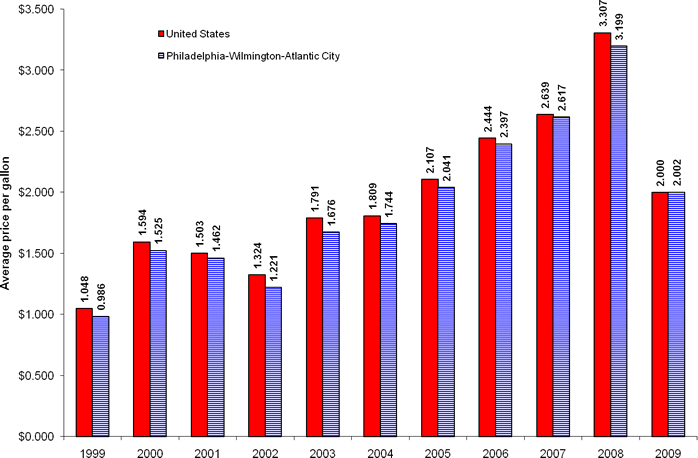| Web site: www.bls.gov/ro3/ | PLS - 4525 For Release: Friday, April 24, 2009 |
||||||||||||||||||||||||||||||||||||||||||||||||||||||||||||||||||||||||||||||||||||||||||||||||||||||||||||||||||||||||||||||||||
| Information: | Gerald Perrins (215) 597-3282 |
||||||||||||||||||||||||||||||||||||||||||||||||||||||||||||||||||||||||||||||||||||||||||||||||||||||||||||||||||||||||||||||||||
| Media Contact: | Sheila Watkins (215) 861-5600 |
||||||||||||||||||||||||||||||||||||||||||||||||||||||||||||||||||||||||||||||||||||||||||||||||||||||||||||||||||||||||||||||||||
AVERAGE ENERGY PRICES IN THE PHILADELPHIA AREA, MARCH 2009 (PDF)Philadelphia area consumers paid more than the U.S. city average for electricity (26.2 percent) and utility (piped) gas (23.1 percent), but about the same as the national average for gasoline (0.1 percent) in March 2009 according to data from the Consumer Price Index (CPI), the Bureau of Labor Statistics of the U.S. Department of Labor. Sheila Watkins, the Bureau’s regional commissioner, noted that local consumers have consistently paid more for electricity and utility gas than the national average during March over the last 10 years. (See table A.) On the other hand, local gasoline prices in March over the last decade were generally lower than or close to those for the United States as a whole.
A kilowatt-hour (kWh) of electricity cost Philadelphia area consumers $0.159 in March 2009, 4.6 percent higher than one year earlier, and 43.2 percent more than in 2000 when the local price was at its lowest in March over the last 10 years. Nationwide, electricity prices averaged $0.126 in March 2009, an increase of 8.6 percent over the year. Electricity prices have generally trended upwards over the decade at both the local and national levels. Philadelphia prices stayed well above the national average as local prices tended to be around 30 percent above the national level with few exceptions (this March among them). (See chart A.) A therm—a measure of constant heating value—of utility (piped) gas, commonly referred to as natural gas, in the Philadelphia area averaged $1.487 in March 2009, a decrease of 3.1 percent from the previous March. Over the year, prices decreased at a faster rate nationally than locally, down 11.0 percent to a price of $1.208 per therm. The local area’s natural gas prices have been above the national price level in March over the last 10 years, though the differences have varied considerably. (See chart B.) The average price per therm in the local area was 23.1 percent higher than the U.S. average in March 2009; this reversed a trend of narrowing price differentials in the last two years. Chart A. Average prices for electricity, United States and Philadelphia area, March 1999-2009
Chart B. Average prices for utility (piped) gas, United States and Philadelphia area, March 1999-2009
Gasoline prices are historically subject to rapid monthly fluctuations. Over the last decade, the price per gallon in the U.S and the Philadelphia area has generally trended upward; however, since last March, gasoline prices dropped 39.5 percent in the U.S. and 37.4 percent in Philadelphia. In March 2009, the price of gasoline in the Philadelphia area ($2.002 per gallon) was almost identical to the national price level ($2.000). Prior to this year, from March 1999 to March 2008, Philadelphia gasoline prices ranged from 7.8 to 0.8 percent lower than the national average. (See chart C.) Chart C. Average prices for gasoline, United States and Philadelphia area, March 1999-2009
The Philadelphia-Wilmington-Atlantic City, Pa.-N.J.-Del.-Md. Consolidated Metropolitan Area includes Bucks, Chester, Delaware, Montgomery, and Philadelphia Counties in Pennsylvania; Atlantic, Burlington, Camden, Cape May, Cumberland, Gloucester, and Salem Counties in New Jersey; New Castle County in Delaware; and Cecil County in Maryland. Additional informationInformation in this release will be made available to sensory impaired individuals upon request. Voice phone: 202-691-5200; TDD message referral phone number: 1-800-877-8339. For personal assistance or further information on the CPI data, as well as other Bureau data, contact the Mid-Atlantic Information Office at 215-597-3282 from 8:30 a.m. to 12:00 p.m. and 1:00 p.m. to 3:30 p.m. ET. Information on the Consumer Price Index and other surveys and programs is available on our Web site at www.bls.gov/ro3/. Technical InformationAverage prices for electricity, utility (piped) gas, and gasoline are published monthly for the U.S. city average, the 4 regions, the 3 population size classes, 10 region/size-class cross-classifications, and the 14 largest local index areas. For electricity, average prices per kilowatt-hour (kWh) and per 500 kWh are published. For utility (piped) gas, average prices per therm, per 40 therms, and per 100 therms are published. For gasoline, the average price per gallon is published. Average prices for commonly available grades of gasoline are published as well as the average price across all grades. Price quotes for 40 therms and 100 therms of utility (piped) gas and for 500 kWh of electricity are collected in sample outlets for use in the average price programs only. Since they are for specified consumption amounts, they are not used in the CPI. All other price quotes used for average price estimation are regular CPI data. With the exception of the 40 therms, 100 therms, and 500 kWh price quotes, all eligible prices are converted to a price per normalized quantity. These prices are then used to estimate a price for a defined fixed quantity. |
|||||||||||||||||||||||||||||||||||||||||||||||||||||||||||||||||||||||||||||||||||||||||||||||||||||||||||||||||||||||||||||||||||
Last Modified Date: March 24, 2009




